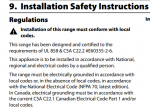I think you nailed it. I actually looked at that table last night and did the math too but didn't connect it to the 45A listed in the User's Guide. Like you said, 5% of 8kW = 0.4kW. 18.5kW - 12kW = 6.5kW. Since Note 1 says "or major fraction thereof", as you said, 6.5 gets rounded up to 7. Thus, 8 + (7 x 0.4) = 10.8kW, which correlates to 45A @ 240V. Not sure why they didn't specify a 45A breaker, but for whatever reason they moved up to 50A.
Now, unless I am looking at this wrong, the major flaw I see with them doing this is that they are assuming that EVERY installation of their range will be able to implement these load diversity calculations. In my second or third post I mentioned that this range is going into a fire station which I do not think qualifies. I have no problem speaking with the CSFM (my AHJ) about this. If they permit this, it will cut down on the OCPD, conductor, and transformer sizes, however, it still leaves me with the concern over the neutral.

